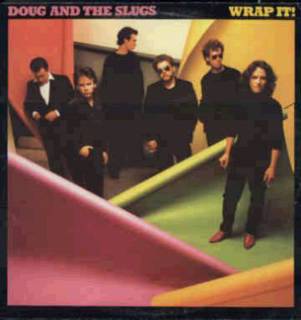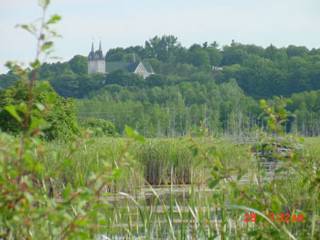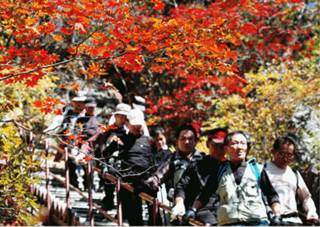I saw
this article in the Korea Herald and thought I would describe my temple stay experience at Naksan Temple. The article is about Jagwang Temple but the basics are the same at every temple.
Experience Buddhist monk life through templestay
A typical weekend visit to the Jagwang Temple runs for 24 hours,
starting on Saturday around 3 p.m. and finishing at the same time
Sunday afternoon. It's an introspective experience, giving the visitor
a glimpse of the solitary lives of Buddhist monks and nuns, while
allowing them to participate in regular temple activities. ...
The Buddhist tea ceremony - a crucial part of being able to able to
free your mind and focus on reflecting upon the world and yourself
- involves learning the meaning of the complex tea preparation rituals
and drinking etiquette. But for Hae Il-shim, what seems like a
painstaking process of carefully washing the teacups and pot before
brewing the tea is actually a highly pleasurable part of her day.
"The tea ceremony helps me to erase myself," she said slowly
sipping tea from a delicate looking kiln-fired green teacup.
"The discipline of the ceremony allows me to find Buddha in my
mind and reminds me that I'm not special. This is a way of
remembering to respect and treat everyone evenly."
...After meditation is finished, it's time for a Q and A meeting
with the temple "seunim" (a respectful way to address a
Buddhist monk or nun in Korea) before heading off to bed
at 10 p.m. During this time, visitors are encouraged to ask
questions or seek advice on Buddhism, personal problems
or even the meaning of life. According to Chong Ah seunim,
the abbot of Jagwang Temple, most foreigners enroll in the
temple stay program because they want to see and experience
the reality of Korean Buddhism. ...With the 5 a.m. ceremony
coming all too quickly, pondering the wisdom of the seunim's
advice from the evening before doesn't seem all that important
as you begin the first of the 108 bows - one for each of the
anguishes or sufferings encountered throughout life's stages.
Prostrating yourself on the ground 108 times to show respect
to Buddha and your Buddhist self is an agonizing experience,
but provides an interesting insight into what it takes to lead a monk's life.
I went to Naksan Temple with 6 friends. [Note, there is a minimum group size, you should enquire when planning a visit.] Five of us lived in Yangyang and had been to the temple at least a few times, while it was the first visit for two. If you want to learn about the temple itself, look on the web or, do a temple stay, I guess.
Planning to stay the night made the whole visit seem different. I knew the grounds as well as any layman. In 2003, a group of diplomats came for a templestay and I was drafted into being a guide for their visit. In preparation, I had to do a fair bit of study on the temple and the region. I knew what many of the paintings meant and who Ui-seung and Won-hyo were. I could even parrot a few Zen lines. Still, I had spoken to only about 3 monks in all my stay in Korea.
The visit was interesting and informative but incomplete; I learned a lot but only intermittently had a glimpse of what a monk's life entailed. The visit felt more like an intense guided tour than an immersion into the life of a monk. I fully understand that 24 hours in a temple is not enough to see the inner workings of a lifetime of devotion, but I wanted more. Just as my 5 days a year working at my in-law's farm doesn't make me farmer, the temple stay didn't give me a lot of insight into the thoughts and motivations of a monk.
Our stay was a busy one. The tour of the site, meditation practice, tea ceremony and evening meal (I probably have the order mixed up) filled the afternoon and evening. Perhaps that really is an example of a monk's life: one of fairly constant work, not the easeful existence imagined by outsiders.
It was also an intense one. My understanding of Buddhist philosophy is that one must do whatever one thing without thinking about other things. Do one thing intensely. The tea ceremony was very atmospheric; inside a temple room of wood and mud and reeds, carefully preparing the tea and thoughtfully savouring it. Our (okay, 'my') attempts to chat were quickly stopped. This was a tea CEREMONY damnit, not a tea SOCIAL.
The trip was a chance to focus on simple things but not to relax in the modern sense.
Our Q and A session with the monk started slowly but picked up as we thought about what we wanted to ask. The monk guiding us was named Pap-gong (and, in my thoughts, I immediately called her Popcorn. She was a biguni, or female monk. I also converted that to bikini. 'Popcorn, the bikini') although we addressed her as Seu-nim, or reverend monk. She was posted at Naksan to help with the templestay program and was separate from the other, male, monks at the temple. She had an elder mentor somewhere else in Korea she visited on occasion and was also mentoring an orphaned high school girl in Pusan. I learned a lot about the rigors of a monk's life when she told us she meditated eight hours a day when she was young but no longer had that much energy so her meditation periods were now shorter.
After the Q & A, she gave us a koan or Seon (Korean Zen) riddle for us to meditate on. I was already in pain from sitting crosslegged for some time and when she asked how long we would like to meditate, I choose the shortest period she suggested, ten minutes. The riddle was doubly difficult because the translator was a little quiet and I wasn't sure if it was 'Why does the whiteboard have hair' or 'Why does the white board have hair?' Perhaps non-teachers wouldn't have that trouble. I was sure that no whiteboard I'd used in class had hair unless someone headbutted the edge by accident while leaving class. After the meditation, another templestayer said of course, it was 'white board' as in lumber. Finally, after speaking to the translator, we learned we had lost ten minutes of our lives because the words were 'white boar' as in male pig. Ah well, I would have just wasted them, chatting.

Ringing the bell

We woke at 3:00 am to do the 108 bows. We went to the main hall in the original part of Naksan temple and joined the service. The monks were in gray and brown and Buddhist students and we visitors were in yellow hanbok. By the way, it isn't just 108 bows, the service included bowing to several of the statues three times each. Then, without warning, the students and monks just kept bowing. We joined in, at our own paces. I was going pretty quickly until I noticed another visitor staying in the full bow position for a few seconds each time. I then tried to slow down and think more about why I was bowing and show a little more respect. Again without warning, everyone started to leave. If I counted the bowing during the service, I think I did the full 108. After leaving the building, I learned that the other visitor was just tired and resting with each box. Dang, I could have made it.
The other visitors went back to bed while I wandered around the temple a bit. The giant standing Buddha looked wonderful, gleaming in the quiet darkness. I was the only one around and I stayed longer than I had previously meditated just enjoying the peace.
After a short nap, we got up again to see the sunrise; Yangyang being famous for it's sunrises. The day dawned very clear, which is nice but slight cloud cover makes for better colors.
After sunrise, we left the temple on our separate ways. The full templestay includes a tour of Sorakdong, the main entrance to Soraksan, with it's giant bronze, sitting Buddha but we were locals and had seen it. I, for one, went home to bed.
Here are some links for those interested:
Click
here for the main templestay website. Naksan's templestays are run by a tour agency called
itour.
Right beside the temple is a
youth hostel. No English.
Finally, about temples and Korean Buddhism, click
here. I bought the book but now it's free online.
 temple information- from the Korea Herald
temple information- from the Korea Herald 
 Halloween in Summer
Halloween in Summer 





 Manchurian Crane
Manchurian Crane .jpg)
.jpg)
.jpg)
.jpg)
.jpg)






